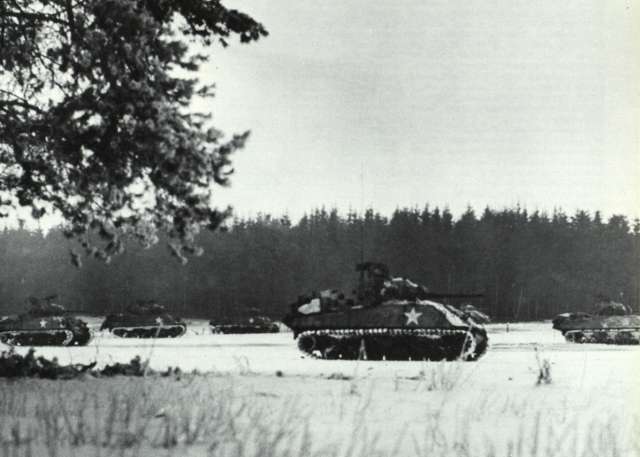From Battlefield to Basketball – Young Tanker Survived, Dedicated Himself to Teaching
Published on May 24 2018 10:21 am
Last Updated on May 24 2018 10:22 am

U.S. tanks during the Battle of the Bulge.
By Dr. Mark DePue, Director of Oral History
Abraham Lincoln Presidential Library
SPRINGFIELD – Arlyn Lober is a familiar name to many in central Illinois. He taught at Lanphier High School from the early 1950s through the mid-1980s and was a highly successful basketball coach for 21 years, taking five teams to the state tournament. But before all of that, in 1944, during one of the darkest moments of World War II, Lober was a newly minted G.I. assigned as a gunner to an M-4 Sherman tank facing his baptism of fire during the Battle of the Bulge.
The Germans gambled big in December 1944, launching a massive offensive on the 16th against unsuspecting Allied forces guarding the Ardennes Forest region of Belgium. The Germans’ objective was to split the Allied forces in half by seizing the port city of Antwerp.
But a stubborn defense by the 101st Airborne Division at Bastogne gave General Eisenhower just enough time to make a gamble of his own. He pulled General Patton’s Third Army out of the line and sent it racing north to hit the underside of the Bulge. The Third Army included Lober’s 42nd Tank Battalion. It’s mission: relieve the beleaguered 101st (the Screaming Eagles) at Bastogne.
The battalion reached the combat zone on December 30, with its tanks lined up like so many ducks as they barreled north.
“I’m peering out of this little telescope…and I see all these tanks in front of us,” Arlyn recalled during an interview with the Oral History Program at the Abraham Lincoln Presidential Library and Museum. “And then the next thing I see is, up there in front of me, [I] see one tank hit and explode, another one over here hit and explode, and then I think somebody decided we better not stay in this formation, and we scattered. That was the first thing I saw, two of our tanks exploding and going up in flames.”
The tanks hastily took up a defensive position on a hillside. The next thing Lober saw were several German light tanks cresting an adjacent ridgeline.
“The tank commander is supposed to tell the gunner the range so that … I can elevate the gun and [set] the proper range and get set to fire it. And he turned the turret and had me set on the target, but he didn’t say anything. So I said, ‘What’s the range?’ and I didn’t get an answer. And the loader’s sitting over there saying, ‘Fire the gun! Fire the gun!’ So I did. …I set the range where I thought it ought to be and I fired and we hit the tank. But the tank commander never said anything. So, as I said, he turned me over to another tank and another tank, but he never said anything all this time.”
Lober fired three times in rapid succession and scored three hits, the only American tank to engage the enemy.
When Lober’s tank moved back to a position with the rest of the company, “the tank commander, who was a lieutenant … got out of the tank and left and I never saw him again. … He was sent back to the hospital and sent home. In other words, he cracked up.”
Lober also soon became a casualty, but in his case it was to the other insidious enemy the G.I.s faced at Bastogne – frostbite. He rejoined his unit three weeks later, now sporting sergeant stripes and ready to take command of his own tank. He ended the war in Austria, still a tank commander, celebrating his twenty-first birthday on V-E Day.
Arlyn Lober touched thousands of students’ lives during his long and illustrious career at Lanphier High School as teacher, coach and mentor. One wonders how many of those students also knew about their teacher’s World War II exploits.
Mark DePue is the Director of Oral History at the Abraham Lincoln Presidential Library. You can listen to Arlyn Lober’s entire story at www.oralhistory.illinois.gov.
For more on the ALPLM’s programs, visit www.presidentlincoln.illinois.gov or follow us on Facebook, Twitter and Instagram.








